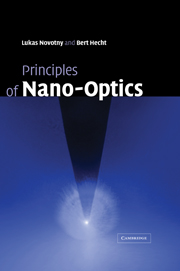Book contents
- Frontmatter
- Contents
- Preface
- 1 Introduction
- 2 Theoretical foundations
- 3 Propagation and focusing of optical fields
- 4 Spatial resolution and position accuracy
- 5 Nanoscale optical microscopy
- 6 Near-field optical probes
- 7 Probe–sample distance control
- 8 Light emission and optical interactions in nanoscale environments
- 9 Quantum emitters
- 10 Dipole emission near planar interfaces
- 11 Photonic crystals and resonators
- 12 Surface plasmons
- 13 Forces in confined fields
- 14 Fluctuation-induced interactions
- 15 Theoretical methods in nano-optics
- Appendix A Semianalytical derivation of the atomic polarizability
- Appendix B Spontaneous emission in the weak coupling regime
- Appendix C Fields of a dipole near a layered substrate
- Appendix D Far-field Green's functions
- Index
14 - Fluctuation-induced interactions
Published online by Cambridge University Press: 05 June 2012
- Frontmatter
- Contents
- Preface
- 1 Introduction
- 2 Theoretical foundations
- 3 Propagation and focusing of optical fields
- 4 Spatial resolution and position accuracy
- 5 Nanoscale optical microscopy
- 6 Near-field optical probes
- 7 Probe–sample distance control
- 8 Light emission and optical interactions in nanoscale environments
- 9 Quantum emitters
- 10 Dipole emission near planar interfaces
- 11 Photonic crystals and resonators
- 12 Surface plasmons
- 13 Forces in confined fields
- 14 Fluctuation-induced interactions
- 15 Theoretical methods in nano-optics
- Appendix A Semianalytical derivation of the atomic polarizability
- Appendix B Spontaneous emission in the weak coupling regime
- Appendix C Fields of a dipole near a layered substrate
- Appendix D Far-field Green's functions
- Index
Summary
The thermal and zero-point motion of electrically charged particles inside materials gives rise to a fluctuating electromagnetic field. Quantum theory tells us that the fluctuating particles can only assume discrete energy states and, as a consequence, the emitted fluctuating radiation takes on the spectral form of blackbody radiation. However, while the familiar blackbody radiation formula is strictly correct at thermal equilibrium, it is only an approximation for non-equilibrium situations. This approximation is reasonable at larger distances from the emitting material (far-field) but it can strongly deviate from the true behavior close to material surfaces (near-field).
Because fluctuations of charge and current in materials lead to dissipation via radiation, no object at finite temperature can be in thermal equilibrium in free space. Equilibrium with the radiation field can only be achieved by confining the radiation to a finite space. However, in most cases the object can be considered to be close to equilibrium and the non-equilibrium behavior can be described by linear response theory. In this regime, the most important theorem is the fluctuation–dissipation theorem. It relates the rate of energy dissipation in a non-equilibrium system to the fluctuations that occur spontaneously at different times in equilibrium systems.
The fluctuation–dissipation theorem is of relevance for the understanding of fluctuating fields near nanoscale objects and optical interactions at nanoscale distances (e.g. van der Waals force). This chapter is intended to provide a detailed derivation of some important aspects in fluctuational electrodynamics.
- Type
- Chapter
- Information
- Principles of Nano-Optics , pp. 446 - 474Publisher: Cambridge University PressPrint publication year: 2006



